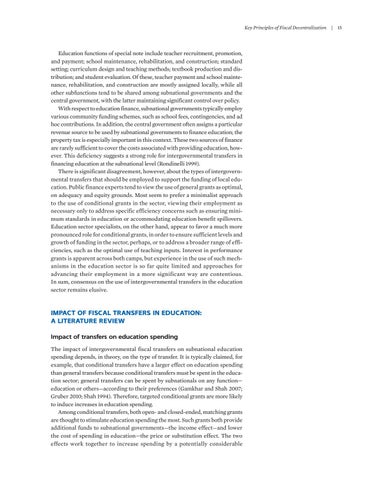Key Principles of Fiscal Decentralization | 15
Education functions of special note include teacher recruitment, promotion, and payment; school maintenance, rehabilitation, and construction; standard setting; curriculum design and teaching methods; textbook production and distribution; and student evaluation. Of these, teacher payment and school maintenance, rehabilitation, and construction are mostly assigned locally, while all other subfunctions tend to be shared among subnational governments and the central government, with the latter maintaining significant control over policy. With respect to education finance, subnational governments typically employ various community funding schemes, such as school fees, contingencies, and ad hoc contributions. In addition, the central government often assigns a particular revenue source to be used by subnational governments to finance education; the property tax is especially important in this context. These two sources of finance are rarely sufficient to cover the costs associated with providing education, however. This deficiency suggests a strong role for intergovernmental transfers in financing education at the subnational level (Rondinelli 1999). There is significant disagreement, however, about the types of intergovernmental transfers that should be employed to support the funding of local education. Public finance experts tend to view the use of general grants as optimal, on adequacy and equity grounds. Most seem to prefer a minimalist approach to the use of conditional grants in the sector, viewing their employment as necessary only to address specific efficiency concerns such as ensuring minimum standards in education or accommodating education benefit spillovers. Education sector specialists, on the other hand, appear to favor a much more pronounced role for conditional grants, in order to ensure sufficient levels and growth of funding in the sector, perhaps, or to address a broader range of efficiencies, such as the optimal use of teaching inputs. Interest in performance grants is apparent across both camps, but experience in the use of such mechanisms in the education sector is so far quite limited and approaches for advancing their employment in a more significant way are contentious. In sum, consensus on the use of intergovernmental transfers in the education sector remains elusive.
IMPACT OF FISCAL TRANSFERS IN EDUCATION: A LITERATURE REVIEW Impact of transfers on education spending The impact of intergovernmental fiscal transfers on subnational education spending depends, in theory, on the type of transfer. It is typically claimed, for example, that conditional transfers have a larger effect on education spending than general transfers because conditional transfers must be spent in the education sector; general transfers can be spent by subnationals on any function— education or others—according to their preferences (Gamkhar and Shah 2007; Gruber 2010; Shah 1994). Therefore, targeted conditional grants are more likely to induce increases in education spending. Among conditional transfers, both open- and closed-ended, matching grants are thought to stimulate education spending the most. Such grants both provide additional funds to subnational governments—the income effect—and lower the cost of spending in education—the price or substitution effect. The two effects work together to increase spending by a potentially considerable






